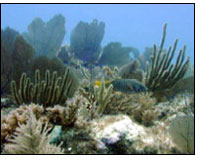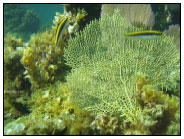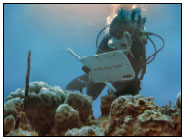Water: Habitat Protection
Coral Reefs

- Introduction
- What is a Coral Reef?
- Why are Coral Reefs Important?
- What is Affecting the Health of Coral Reefs?
- How Does EPA Protect Coral Reefs?
- What Can You Do To Protect Coral Reefs?
- How Can I Obtain More Information?
PDF version (2 pp, 270K, About PDF)
Introduction
Living coral reefs are the foundation for many marine species, and thus a crucial support for human life. The coral reef ecosystem is an intricate and diverse collection of species that interact with each other and the physical environment. Coral reefs are the homes of many species including crabs, shrimp, oysters, and clams. They also provide extensive recreational and tourism opportunities.
Coral reefs are among the most diverse and biologically complex ecosystems on earth, supporting 33% of marine fish species, according to U.S. Coral Reef Task Force (CRTF).
Reef-building corals grow where the water is clear, warm, and shallow. These conditions occur in tropical waters near the equator, on the eastern sides of continents and around oceanic islands.
According to the CRTF, an estimated 70% of the world's reefs have been threatened or destroyed by a variety of stressors, including shoreline development, polluted runoff from agriculture, physical damage, over-harvesting of fish, destructive fishing, diseases, and warmer seawater temperatures.
What is a Coral Reef?
Coral reefs are colonies of various types of reef-building stony hard corals. Each coral colony is composed of tiny animals, also known as polyps. Polyps stay fixed in one place to create a colony that provides a home to symbiotic algae.

Each polyp slowly secretes a hard calcium carbonate skeleton, which serves as the base or substrate for the colony. The living animal or polyp attaches itself to the skeletal base that it creates. The skeleton provides protection for the polyps and algae as predators approach.
Calcium carbonate is continuously deposited by the corals in the living colony, adding to the size and structure of the reef. It is these slow-growing hard skeletal structures that build up coral reefs over long periods of time.
Why are Coral Reefs Important?
Coral reefs provide a source of food and shelter for a large variety of species including fish, shellfish, fungi, sponges, sea anemones, sea urchins, sea snakes, sea stars, worms, jellyfish, turtles, and snails.
Coral reefs protect coastlines from ocean storms and floods.
Coral reefs are environmental indicators of water quality because they can only tolerate narrow ranges of temperature, salinity, water clarity, and other water conditions.
Coral reefs make important contributions to local economies because they attract millions of tourists every year to enjoy beaches, water sports, and other activities.
Coral reefs are important sources of new medicines that can be used to treat diseases and other health problems.
What is Affecting the Health of Coral Reefs?
Humans contribute to the deterioration of coral reefs through physical damage caused by boats and recreational contact, and through runoff of sediments, contaminants, and nutrients from agriculture, industry, sewage, and land clearing in the watershed.

Coral bleaching slows the growth and reproduction of corals. Bleaching occurs when environmental conditions no longer support the symbiotic relationship with photosynthetic algae, or zooxanthellae, found in coral polyps. When the colored algae leave the coral, the coral loses its color (bleaches) and its source of food.
Over the last three decades, several new coral diseases have caused widespread mortalities. The responsible agents are known in only a few cases, and some diseases may be caused by multiple organisms. Poor water quality, increased pollution, and elevated water temperatures increase the likelihood of coral disease.
How Does EPA Protect Coral Reefs?
EPA has several programs that contribute to the protection of coral reefs. These include research into the causes of coral reef deterioration and regulatory control programs for wastewater discharges, storm water runoff, and ocean dumping of wastes.

EPA scientists onboard EPA’s Ocean Survey Vessel Bold monitor and assess the impacts of natural and human-caused impacts on coral reefs such as the potential effects of dredged material disposal or discharges from sewage treatment plants.
EPA participates in the U.S. Coral Reef Task Force. The mission of the interagency Task Force is to lead, coordinate, and strengthen U.S. Government actions to better preserve and protect coral reef ecosystems.
EPA is supporting the development of biological assessment methods and biological criteria for states, tribes and territories to use in evaluating the health of coral reefs and associated water quality. These methods will help us identify reefs at risk and assess the effectiveness of protection techniques.
EPA supports implementation of the United Nations Environment Programme’s Global Programme of Action to address marine degradation from land-based activities in countries with coral reefs.
What Can You Do To Protect Coral Reefs?
- Do not touch corals when snorkeling or SCUBA diving.
- Use installed buoys instead of anchors.
- Do not use chemically enhanced fertilizers or pesticides.
- Volunteer for a coral clean-up.
- Support organizations that protect corals reefs.
How Can I Obtain More Information?
- Visit our website at www.epa.gov/owow/oceans/coral/index.html.
- Contact the Ocean and Coastal Protection Division at 202-566-1200.
Office of Water
Office of Wetlands, Oceans, and Watersheds
1200 Pennsylvania Ave., N.W. (Mail Code 4504T), Washington, D.C. 20460
EPA-842-F-05-001h
October 2005
